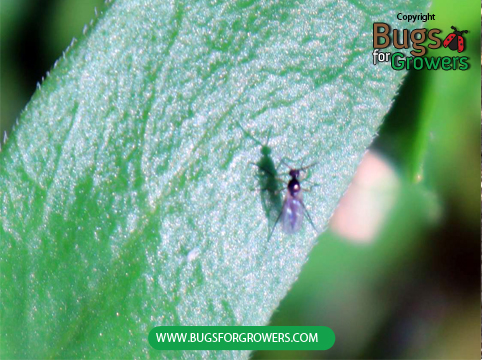What are fungus gnats?
Fungus gnats (Bradysia spp.) are one of the most economically important insect pests of many plant species grown in the greenhouses, nurseries and residential houses. Adult gnat flies are very tiny, blackish to grayish colored flies with clear wings (Photo 1). Females lay whitish shiny and oval shaped semitransparent eggs. Fungus gnat larvae (maggots) are legless, whitish in color with translucent bodies and black head capsules. Fungus gnat pupae are brown in color and very small in size.

Life cycle of fungus gnats
Life cycle of fungus gnats includes four life stages: eggs, larvae, pupae and adults. Females often lay over 200 eggs singly or in clusters on the surface of media or soil. Eggs hatch into small maggots within a week. Newly hatched young maggots immediately start feeding on plant tissues and become mature within 2 weeks. Matured maggots then pupate near the soil surface. Adults fungus gnats emerge from pupae within a week. Fungus gnats generally complete their life eggs- to- adults life cycle within 20-25 days and several overlapping generations in a year in the greenhouse at 20-25°C.
Direct damage
Fungus gnat adults do not cause direct damage to plants but they are a nuisance to workers and people. Although fungus gnat larvae primarily feed on fungi and organic matter, they are known to cause serious feeding damage to the healthy roots and stems of many plant species. Feeding damage generally includes chewing or stripping of roots and making tunnels in stem tissues of young seedlings and cuttings. Damaged plants lose their ability to absorb water and nutrients from soil or potting media. The major symptoms of damage caused by maggots include poor and stunted growth, loss of vigor, yellowing, premature dropping of leaves and eventually death of plants.
Indirect damage
Both adults and maggots of fungus gnats cause indirect damage to plants by disseminating spores of diseases like botrytis blight, fusarium wilt, pythium blight and verticillium wilt from plants to plants when adults disperse through the greenhouse and when maggots are feeding on the plants. Severely diseased plants generally die quickly that in turn can cause tremendous economic loss to growers.
Biological control of fungus gnats
Two biological control agents including beneficial Steinernema feltiae nematodes and predatory mites, Stratiolaelaps scimitus (Hypoaspis miles) have potential to control fungus gnats.
1. Beneficial entomopathogenic Steinernema feltiae nematodes
Beneficial entomopathogenic Steinernema feltiae nematodes are thread- like unsegmented roundworms that are currently used as biological control agents for the control of fungus gnats in the greenhouses and interior landscapes. These commercially available nematodes are easily mixed in water and applied in pots or greenhouse beds using simple water cans with sprinkler heads.
How do nematodes control fungus gnats?
When the infective juvenile nematodes are applied to the soil/ potting medium surface, they actively search for maggots (larvae) and pupae of fungus gnats in the soil profile. After locating maggots and/or pupae, Steinernema feltiae nematode juveniles enter via mouth, anus and breathing pores into their body cavity containing blood (hemolymph). Once in the body cavity, nematode juveniles will release symbiotic bacteria (Xenorhabdus spp.) in the blood of maggots. These bacteria will multiply exponentially in the insect blood and cause septicemia that kills both the larvae and pupae usually within 48 hours after infection. This is how Steinernema feltiae nematodes will control fungus gnats in the greenhouses and interior landscapes.
Optimum rate of beneficial nematodes
The optimum rate of nematodes for the effective control of both the larvae and pupae of fungus gnat is 500 -1000 infective juvenile nematodes per gallon pot or 23000 infective juveniles per square foot area of a bed. Nematodes are generally applied to the surface of the potting medium/soil using a water can with a sprinkler head.
2. Beneficial predatory Stratiolaelaps scimitus mites
Beneficial predatory Stratiolaelaps scimitus (old name- Hypoaspis miles) mites are commercially available as a mixture of eggs, nymphs and adults and widely used as a biological control agent for the control fungus gnats infesting crops that are grown in the greenhouses and other interior landscapes. These predatory mites can be easily released in the greenhouses and interior landscapes and achieved effective control of fungus gnats.
Identification and life cycle of Stratiolaelaps scimitus mites
Adults of Stratiolaelaps scimitus mites are clear-brown colored tiny (size: 0.8- 1.0 mm) mites. Females mites lay oval shaped eggs in the soil/ potting mix. Eggs hatch into small six legged larvae that develop through two successive protonymphal and deutonymphal developmental stages that resemble their parents. The optimum temperature and relative humidity required for the reproduction, development and completion of the egg- to- egg life cycle of Stratiolaelaps scimitus is between 15 and 25°C (59 and 77°F) and 40 and 60%, respectively.
How Stratiolaelaps scimitus mites control fungus gnats?
Immediately after releasing, both the adults and nymphs of Stratiolaelaps scimitus mites will quickly disseminate themselves throughout the soil/media profile and start munching on the eggs, maggots and pupae of fungus gnats and thus, control their populations.
When is the best time to release Stratiolaelaps scimitus mites?
The best time to release Stratiolaelaps scimitus mites is when the surrounding temperature is between 15- 25°C (59-77°F) and the relative humidity is between 40-60%.
Preventive control
For a preventive control measure, these mites should be released when there is a very low population of fungus gnats in the greenhouses.
Curative control
For a curative measure, release these mites when there is a large population of fungus gnats. Under favorable environmental conditions and if there is enough food around, these mites tend to recycle themselves continuously so that there is no need to reapply them again and again. This is how these mites will keep the fungus gnat population under economic threshold level.
Optimum rate of Stratiolaelaps scimitus mites
For the effective control of fungus gnats, release 5000- 10,000 mites per 1000 square foot area or 25,000- 50,000 mites per acre depending on the level of fungus gnat infestation.
